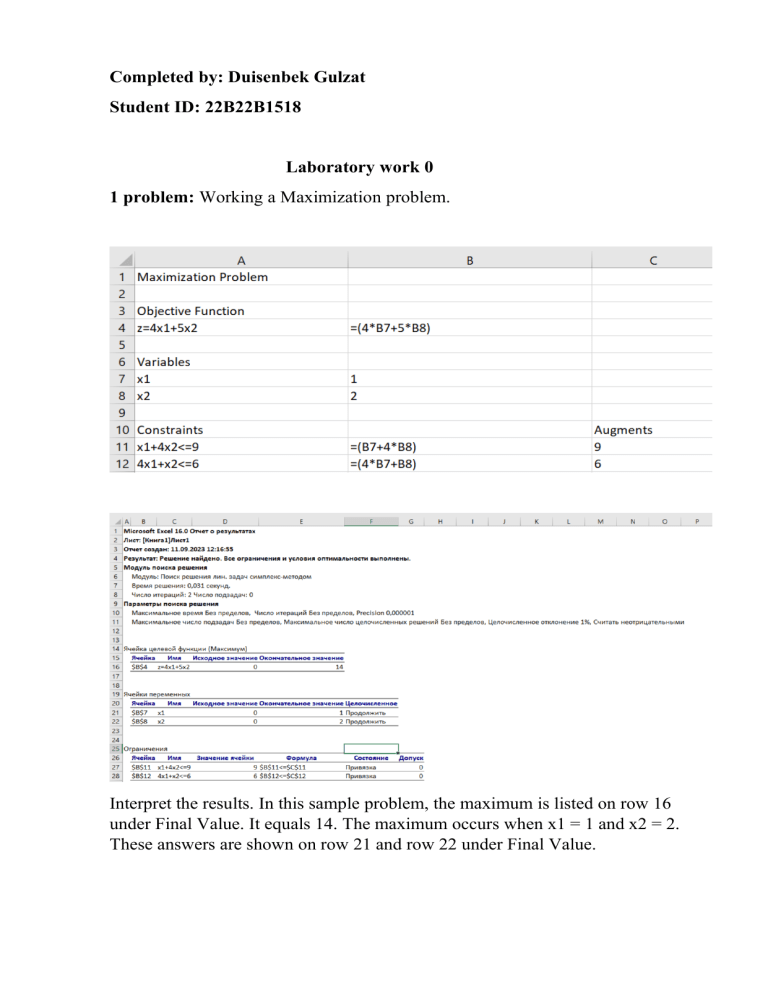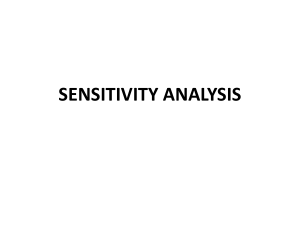
Completed by: Duisenbek Gulzat Student ID: 22B22B1518 Laboratory work 0 1 problem: Working a Maximization problem. Interpret the results. In this sample problem, the maximum is listed on row 16 under Final Value. It equals 14. The maximum occurs when x1 = 1 and x2 = 2. These answers are shown on row 21 and row 22 under Final Value. Sensitivity Analysis 1. What is the range of values that the coefficient of the first variable can have? The range of values for the coefficient of x1 is determined by the "Allowable Increase" and "Allowable Decrease" values in the Sensitivity Report. These values indicate how much the coefficient of x1 can change while the optimal solution remains the same. 2. What is the range of values that the coefficient of the next variable can have? Continue for each variable in the objective function. Similarly, the range of values for the coefficient of x2 can be found in the Sensitivity Report using the "Allowable Increase" and "Allowable Decrease" values. 3. What is the range of values that constant in each constraint can have? For each constraint, the Sensitivity Report provides "Allowable Increase" and "Allowable Decrease" values for the constant (the right-hand side of the constraint). These values indicate how much the constant can change while the optimal solution remains unchanged. 4. What is the shadow price? Explain what this means in terms of the problem. The shadow price represents how much the objective function's optimal value would change per unit increase in the right-hand side of each constraint while keeping other variables at their current optimal values. In our problem, we have two constraints: "x1 + 4x2 <= 9" and "4x1 + x2 <= 6." The shadow prices for these constraints can be found in the Sensitivity Report. A positive shadow price indicates that increasing the right-hand side of the constraint will increase the optimal objective value, meaning it's beneficial to have more resources available for that constraint. A zero shadow price means that the constraint is not affecting the optimal solution; changes in its right-hand side won't impact the objective value. 5. Is the shadow price binding or non-binding? A positive shadow price indicates a binding constraint, meaning that the constraint is affecting the optimal solution. A zero shadow price indicates a non-binding constraint, meaning that the constraint is not affecting the optimal solution. 2 problem: A firm makes two types of furniture’s, chairs and tables. Profits are 20 per chair and 30 per table. Both products are processed on three machines M1, M2 and M3. The time required for each product in hours and total time available in hours per week on each machine are as follows: Final solution: As per the given solution, firm can have maximum profit of 330 by producing 3 chairs and 9 tables per week. Questions for Practice: 1. A diet is to contain at least 20 ounces of protein and 15 ounces of carbohydrate. There are three foods A, B, and C available in the market, costing Rs. 2, Re. 1, and Rs. 3 per unit respectively. Each unit of A contains 2 ounces of protein and 4 ounces of carbohydrate. . Each unit of B contains 3 ounces of protein and 2 ounces of carbohydrate; each unit of C contains 4 ounces of protein and 2 ounces of carbohydrate. Formulate the LPP so as to minimize the cost of diet and solve using Excel Solver. Let x, y and z = number of units of food A,B and C, respectively which a diet must contain. Min (total cost) Z = 2x + y + 3z subject to 2x+3y+4z≥20 4x+2y+2z≥15 x,y,z≥0 This objective function represents the total cost of the diet, where the cost of each unit of food A is Rs. 2, food B is Re. 1, and food C is Rs. 3.



